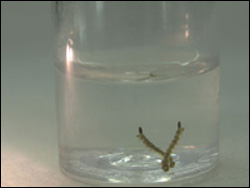Prevalence of infection in a population can shape parasite virulence

By accounting for competition between infected and uninfected mosquitoes, researchers discovered a link between parasitic virulence and the prevalence of infection in a population.
If necessity is the mother of invention, the coevolutionary arms race is the mother of adaptation. For parasites and hosts engaged in an ongoing battle to gain advantage, those adaptations take many forms. In a new analysis in the premier open access journal PLoS Biology, Stephanie Bedhomme, Yannis Michalakis, and colleagues extend traditional methods of studying the coevolution of parasite virulence and host life history traits by introducing an additional variable: intraspecific competition between hosts. Unsurprisingly, the authors find that infected individuals pay a cost compared to their healthy counterparts. But surprisingly, both infected and uninfected individuals do better when their competitor is infected: parasite costs ¡Vand virulence ¡V therefore depend on the infection status of the competitors and for an infected mosquito, at least, you stand a better chance of getting your wings and leaving the natal lagoon if more of your larval neighbors are infected too.
To study the interplay between parasitism and intraspecific competition, Bedhomme et al. worked with the yellow fever mosquito Aedes aegypti and its natural enemy, the single-celled parasite Vavraia culicis. They divided recently hatched mosquito larvae into groups of 60 larvae, and exposed half of the groups to the parasite. Larvae were then placed two by two into vials. Vials contained either two uninfected larvae, two infected larvae, or one infected and one uninfected individual. Infected pairs took longer to develop than uninfected pairs, as expected. But with infected and uninfected pairs, infected larvae took longer to develop than their healthy partners, meaning they are more likely to succumb to the parasite. Competing against a healthy partner increased virulence by increasing development time. Interestingly, however, infected mosquitoes also fared better when paired with an infected competitor. These results suggest that a high incidence, or prevalence, of parasitic infection in the population means that healthy larvae face less competition and do better than they would if they had to compete with healthy individuals. Infected individuals will also do better if there’s a high prevalence of infection because they are more likely to compete against equally poor competitors. Thus, by ignoring the effects of competition, standard models underestimate the full costs of virulence – and, more important, miss a significant link between a parasite’s prevalence in a population and its virulence.
Media Contact
All latest news from the category: Life Sciences and Chemistry
Articles and reports from the Life Sciences and chemistry area deal with applied and basic research into modern biology, chemistry and human medicine.
Valuable information can be found on a range of life sciences fields including bacteriology, biochemistry, bionics, bioinformatics, biophysics, biotechnology, genetics, geobotany, human biology, marine biology, microbiology, molecular biology, cellular biology, zoology, bioinorganic chemistry, microchemistry and environmental chemistry.
Newest articles

A universal framework for spatial biology
SpatialData is a freely accessible tool to unify and integrate data from different omics technologies accounting for spatial information, which can provide holistic insights into health and disease. Biological processes…

How complex biological processes arise
A $20 million grant from the U.S. National Science Foundation (NSF) will support the establishment and operation of the National Synthesis Center for Emergence in the Molecular and Cellular Sciences (NCEMS) at…

Airborne single-photon lidar system achieves high-resolution 3D imaging
Compact, low-power system opens doors for photon-efficient drone and satellite-based environmental monitoring and mapping. Researchers have developed a compact and lightweight single-photon airborne lidar system that can acquire high-resolution 3D…





















